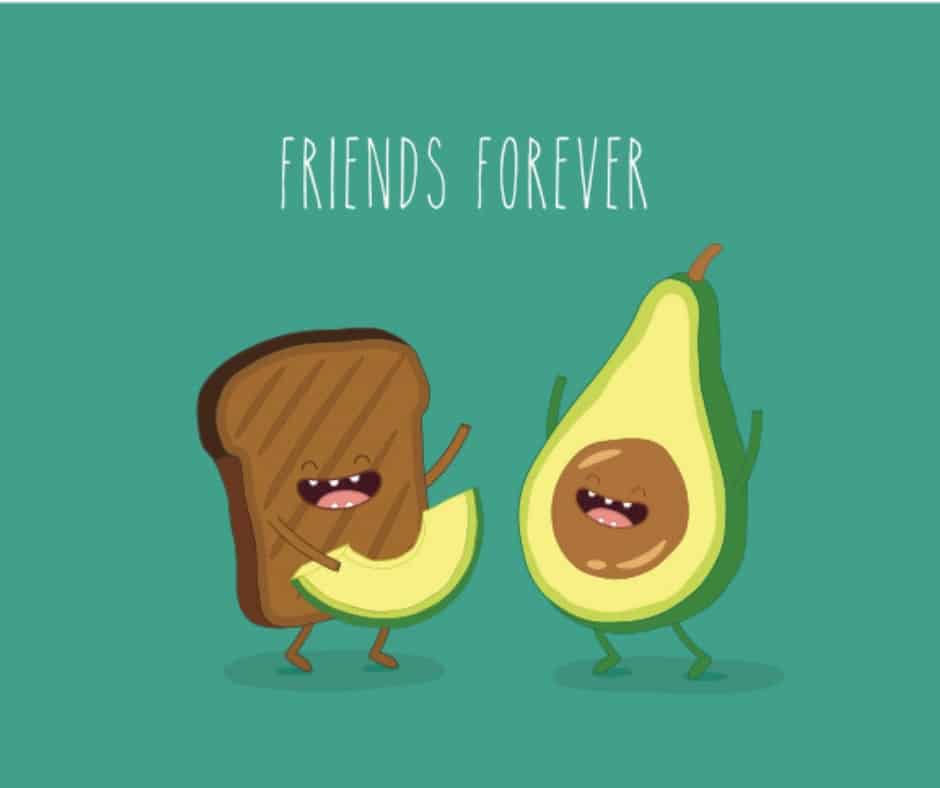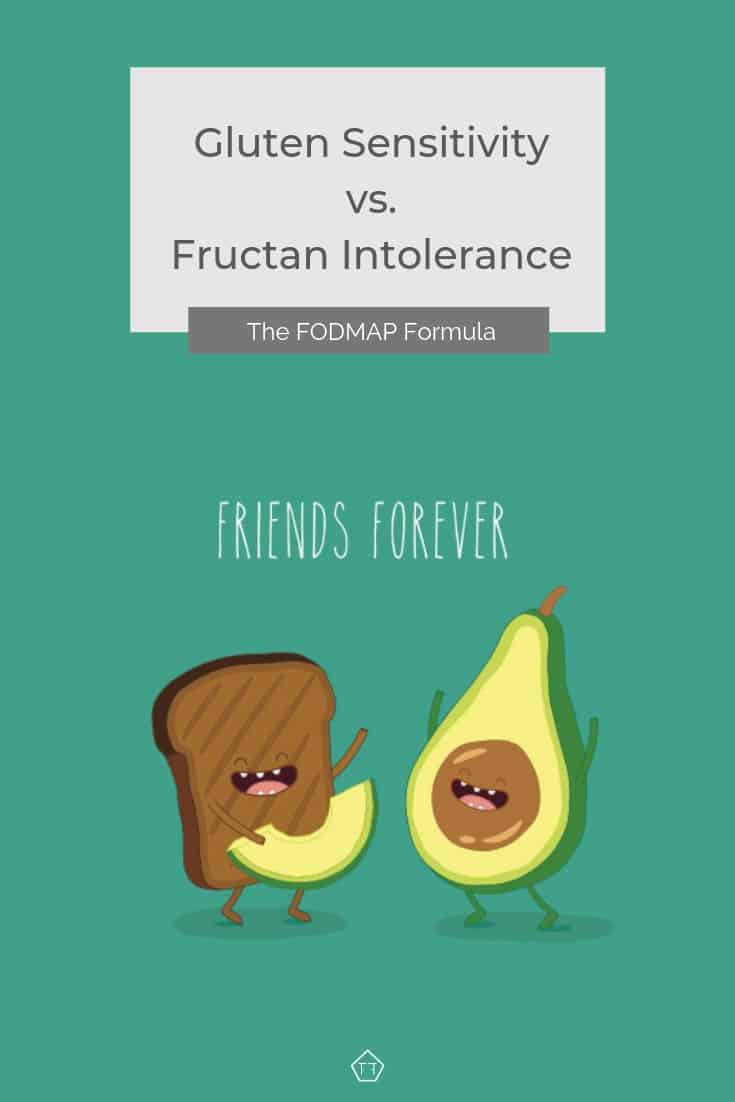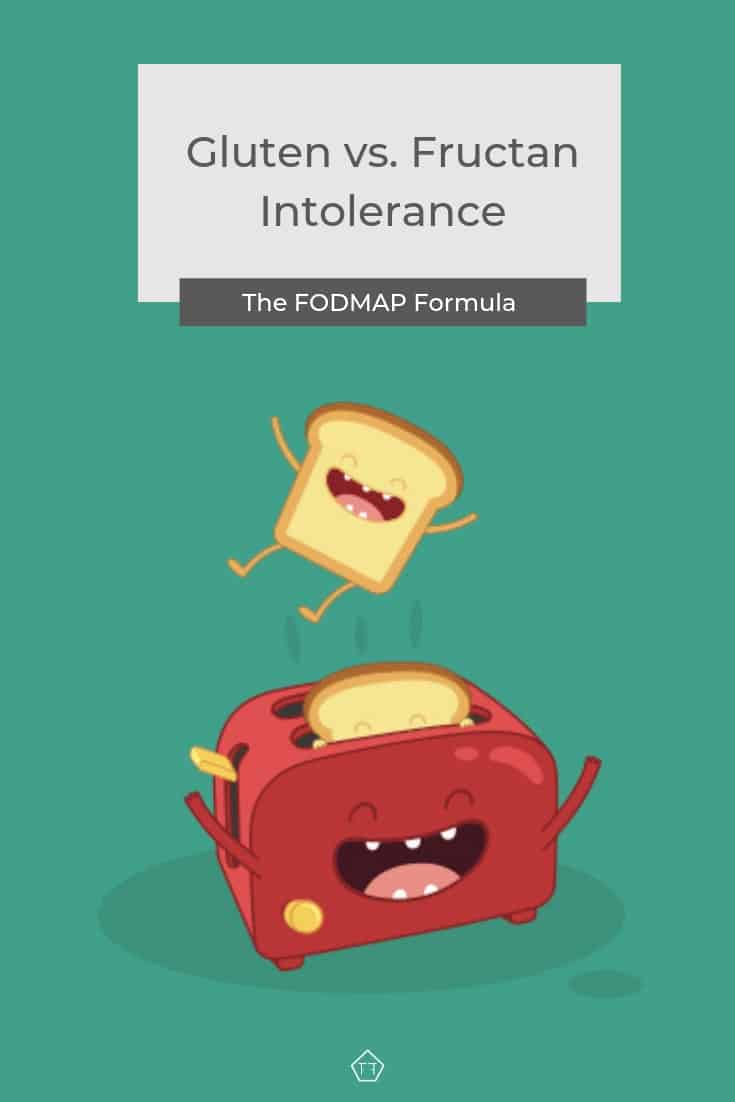Gluten has gotten a bad wrap over the last few years. So, it’s often the first thing that comes to mind when digestive troubles hit. Especially, if you feel better once you pull it out of your diet. But, heads up, gluten isn’t the only thing in your grains! Is your gluten sensitivity really an intolerance to fructans? Let’s find out!

Along with other dietary proteins, carbohydrates, and fibres, gluten-containing grains also contain FODMAPs. FODMAPs are a group of small carbohydrates that hide in a ton of common foods. There are 5 FODMAP groups, each of which likes to hang out in specific places. The FODMAP fructan, for example, likes to hang out in gluten-containing grains.
In this article, we’ll talk about the difference between celiac disease and non-celiac gluten sensitivity, and discuss the possibility that your gluten sensitivity is really an intolerance to fructans. Ready? Let’s jump in!
What Is Celiac Disease?
First, let’s make sure we’re all starting on the same page. Gluten is the generic name used to talk about the proteins in grains like wheat, rye, and barley. Gluten is like the glue that holds foods together. It improves their shape, texture, and elasticity.
Celiac disease is an autoimmune disorder that currently affects about 1% of the population. If you have celiac disease, when you eat gluten, your body reacts like you’ve ingested a pathogen (something that can harm you). This activates your immune system which releases specific antibodies including tissue transglutaminase antibody (TTG), endomysial antibody (EMA), and deamidated gliadin peptide (DGP).
When doctors perform a serologic blood test to screen for celiac disease, these are the antibodies they’re looking for. A small biopsy is taken from the small intestine to confirm the disorder.
Because both tests measure your body’s reaction to gluten, you need to continue eating foods containing gluten until celiac disease has been officially ruled out. This is one of the reasons it’s important to consult your healthcare team before transitioning to a gluten-free diet.
If your doctor confirms you have celiac disease, you’ll need to avoid gluten by following a strict gluten-free diet for life to prevent long-term damage to your body.

What Is Non-Celiac Gluten Sensitivity?
Non-celiac gluten sensitivity, also called non-celiac wheat sensitivity or gluten-sensitivity, occurs in people who have symptoms eerily similar to celiac disease (like abdominal pain, bloating, disordered bowel movements, brain fog, muscle or joint pain, rashes or blisters on the skin or in the mouth, etc), but their bodies don’t produce the expected antibodies and there are no signs of damage in small intestine.
How Many People Have Non-Celiac Gluten Sensitivity?
Depending on where you look, the number of reported people with non-celiac gluten sensitivity varies between 0.5 – 13% of the population. One reason the range is so wide is that there are no physical markers to confirm NCGS. This means there may be people grouped under the NCGS umbrella who don’t really belong there (like those with undiagnosed celiac disease or people with irritable bowel syndrome).
This problem can be especially troublesome for researchers trying to study NCGS. Unless they conduct their tests using isolated gluten, they have no way of knowing what part of the test food each participant is reacting to.
For example, gluten-containing grains like wheat, barley, and rye also contain the FODMAP fructan, along with other dietary proteins and fibres. Since NCGS and IBS reactions can be quite similar, it can be hard to determine whether a study participant is reacting to gluten or fructans.
This was the case in a double-blind crossover study completed in 2013. In this study, 37 people who self-reported non-celiac gluten sensitivity followed a low FODMAP diet for two weeks. Then they were randomly assigned to a high-gluten, low-gluten, or a control diet for one week. This was followed by a two week washout period.
The participants then “crossed over” to a different group and followed either a high-gluten, low-gluten, or control diet for three days.
After each test, participants were screened for signs of intestinal inflammation and injury, as well as immune activation and signs of fatigue.
When the study was complete, all of the participants had seen consistent improvements in their symptoms while following the low FODMAP diet. But, they had a similar if not an equal reaction to the gluten and whey protein. In fact, only 8% of the participants showed gluten-specific symptoms.
In a second study completed in 2018, 59 people who had self-reported non-celiac gluten sensitivity were given a muesli bar containing either gluten, fructans, or a placebo for seven days, followed by a washout period. Once completed, each participant crossed over to a different group and completed the test again. This was cycle was repeated until each participant had finished all three challenges.
After the study, researchers determined fructan, not gluten, triggered symptoms in most of the study participants. Does this make you consider if your gluten sensitivity really is an intolerance to fructans?

What the Heck is A Fructan?
Fructan is one of 5 short-chain carbohydrates that trigger digestive symptoms in many IBS patients. These tiny sugar groups are called FODMAPs, and they can cause a whole range of digestive issues!
When a normal person eats high FODMAP foods, the carbohydrate chains are broken down during digestion and absorbed by the small intestine. But, if something isn’t working quite right, the chains can’t be absorbed. So instead, they travel down to the large intestine (colon).
While FODMAPs cruise around your digestive tract, they can pull water into your intestines causing cramping, bloating, and abdominal pain, as well as digestive issues like constipation or diarrhea. Once FODMAPs reach the large intestine, they’re quickly fermented by your gut bugs who create excess gas, leading to more discomfort and digestive issues.
Fructans are found in grains like wheat, rye, and barley, as well as vegetables like garlic and onion, among other things.
So, Is Your Gluten Sensitivity Really an Intolerance to Fructans?
If cutting out gluten-containing foods makes you feel better, it makes total sense you would think you suffer from gluten intolerance. But, it’s important for your overall health to make sure you’ve identified the actual trouble maker!
First of all, if you have celiac disease, cutting gluten from your diet will make it harder to get the correct diagnosis. Remember, tests for celiac disease look for antibodies reacting to the presence of gluten and damage to your small intestine. So, if you haven’t been eating gluten regularly, your body may not show the signs and symptoms of the disease, even if it’s still lurking.
Since celiac disease can cause lasting damage to the body, people with celiac disease need to be vigilant about avoiding contact with gluten – including avoiding cross-contaminated foods and work surfaces. So, if you have it, you’ll want to know sooner rather than later.
If, however, the issue is really a sensitivity to digesting fructans (or FODMAPs in general), there are some other things you need to consider. For example, FODMAPs don’t cross-contaminate. So, while you may keep ingredients like wheat out of your diet, you won’t need to worry about stray FODMAPs crashing your meal. This can make dining out and travelling much easier, as you don’t need to find designated gluten-free kitchens.
If you’re sensitive to fructan-containing grains, you should also consider investigating other foods that contain different types of fructans (like fruits and vegetables and non-gluten grains like amaranth and inulin) as these may also trigger your symptoms.
Heads up! Unlike celiac disease or non-celiac gluten sensitivity, FODMAP reactions are based on your personal threshold. So, while you may still need to cut out gluten-containing grains like wheat, you may be able to have small servings of other fructan-containing foods in your long-term diet.
How Do You Know if You’re Intolerant to Fructans?
Currently, the most reliable way to determine if you react to fructans is to perform an elimination diet and re-challenge. During an elimination/rechallenge program, you would remove all sources of fructan from your diet for at least two weeks, then test foods containing fructans to see if you react.
If you suspect you have more than one food sensitivity, ask your healthcare team about trying the low FODMAP diet. The low FODMAP diet is a short-term program used to test all five FODMAP groups at once (including fructose, lactose, fructans, galactans, and polyols). If you suspect you have multiple sensitivities, this is one of the most effective ways to systematically test which foods you’re actually reacting to.
Final Thoughts
So, is your gluten sensitivity really an intolerance to fructans? That was a ton of information, so let’s recap. Non-celiac gluten sensitivity occurs when a person experiences symptoms of celiac disease when eating gluten-containing grains, but their bodies don’t produce the antibodies or show the physical damage used to diagnose celiac disease.
While many people report having NCGS, research is starting to show that many NCGS patients may be reacting to the FODMAP fructan, which appears also appears in gluten-containing grains. This would explain why people with NCGS do not show signs of celiac disease, but their symptoms improve when removing gluten from their diets.
You might also like one of these:
What Are Prebiotics and Probiotics? Wondering if adding probiotics or prebiotics to your daily routine will help tame your IBS symptoms? Here’s the scoop on how these cheeky little bugs can help or hurt you.
What Is Referred Pain? You already know IBS can be a pain in the butt! But, did you know it can also be a pain in the back? Check out this article for everything you need to know about why and how referred pain happens.
What Is Irritable Bowel Syndrome? Wondering if your digestive issues add up to IBS? Check out this article for everything you need to know about irritable bowel syndrome!
If you like this post, don’t forget to share it! Follow me on Instagram @fodmapformula for more FODMAP-friendly tips and recipes! Together we’ll get the low FODMAP diet down to a science!


References
- Biesiekierski, J., Peters, S., Newnham, E., Rosella, O., Muir, J., & Gibson, P. (2013). No effects of gluten in patients with self-reported non-celiac gluten sensitivity after dietary reduction of fermentable, poorly absorbed, short-chain carbohydrates. Gastroenterology., 145(2), 320. doi:10.1053/j.gastro.2013.04.051
- Canadian Celiac Association. (n.d.). Non-Celiac Gluten Sensitivity. Retrieved from https://www.celiac.ca/gluten-related-disorders/non-celiac-gluten-sensitivity/
- Rej, A., & Sanders, D. (2019). The overlap of irritable bowel syndrome and noncoeliac gluten sensitivity. Current Opinion in Gastroenterology. doi:10.1097/MOG.0000000000000517
- Skodje, G., Sarna, V., Minelle, I., Rolfsen, K., Muir, J., Gibson, P., . . . Lundin, K. (2018). Fructan, rather than gluten, induces symptoms in patients with self-reported non-celiac gluten sensitivity. Gastroenterology, 154(3), 529-539. doi:10.1053/j.gastro.2017.10.040.
- SOARES, R. L. (2018). Irritable Bowel Syndrome, Food Intolerance and Non-Celiac Gluten Sensitivity. A New Clinical Challenge. Arquivos De Gastroenterologia, 55(4), 417-422. Retrieved from http://www.scielo.br/pdf/ag/v55n4/1678-4219-ag-55-04-417.pdf
